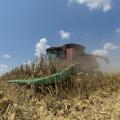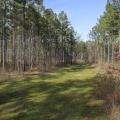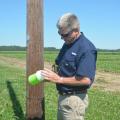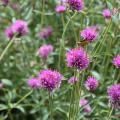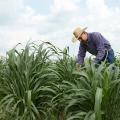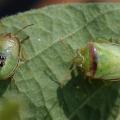News From 2017
STARKVILLE, Miss. -- Mississippi producers are optimistic that the remnants of Hurricane Harvey that moved through the state in late August were not enough to stop corn harvests from reaching a new record.
As of Aug. 27, the U.S. Department of Agriculture estimated 51 percent of the corn crop was harvested. Growers had a few more days to tackle remaining acres before rains came through the state. USDA estimated that 78 percent of the crop was in good or excellent shape.
Erick Larson, grain specialist with the Mississippi State University Extension Service, said many early yields exceeded 200 bushels an acre, with dryland acreage producing at almost the same rate as irrigated acres. The state’s record average yield was 185 bushels set in 2014.
STARKVILLE, Miss. -- Those of us with a strong connection to the natural world know that attachment was born and strengthened through personal experiences we had outdoors as children, generally when family members took us outside to spend time, relax or have fun.
A new nationwide program began in 2015 with hopes of increasing access to federal public lands for fourth-grade students, along with the goal of establishing connections to the outdoors. Every Kid in a Park begins its third year on Sept. 1, 2017. Every fourth-grader has easy access to a free pass for admission to public land from Sept. 1 through Aug. 31, 2018.
CRYSTAL SPRINGS, Miss. -- Home gardeners and horticulture professionals can learn about the latest plants, research and gardening techniques during the 39th annual Fall Flower & Garden Fest on Oct. 13 and 14.
This year has been a challenge in my home landscape and garden.
First, we have had a lot of rain: more than 93 inches and counting collected in our Community Collaborative Rain, Hail & Snow Network rain gauge. If you’re interested in being a volunteer rain reporter for them, go to http://www.cocoraahs.org for more information. I’ve seen so many waterlogged landscape beds and lawns that just won’t dry out.
The second big challenge was the heat. When it’s not raining, the high temperatures and humidity have maintained heat indexes that make me -- and many others gardeners -- just stay indoors. Surely that yard work can be put off until October.
But I’ve taken the steps to make my gardening an easier chore
STARKVILLE, Miss. -- A new record has been set in the Gulf of Mexico, but it is not one to brag about because it threatens a multibillion-dollar fishing industry.
The most recent Gulf dead zone measured in the summer of 2017 was the largest ever recorded in 32 years of monitoring. It covered 8,776 square miles, which is closer to the size of New Jersey than the average zone size of 5,309 square miles. Reducing the size of the hypoxic zone is important if we want to ensure continued productivity of the Gulf fishery.
STARKVILLE, Miss. -- The combination of a middling timber market, a pine beetle infestation and wet weather is doing Mississippi tree farmers no favors this year.
Fortunately, a new sawmill in the state and the prospect of increased manufacturing gives reason for optimism long-term.
Biewer Sawmill began operations this year in Newton. Glenn Hughes, a forestry professor with the Mississippi State University Extension Service, said this indicates an upswing for the state’s forest product industry.
STARKVILLE, Miss. -- Mississippi homeowners with private wells have three opportunities to learn how to enhance the quality of their drinking water sources.
The Mississippi Well Owner Network, a program of the Mississippi State University Extension Service, will hold workshops at the Extension offices in Wayne County Sept. 26, Pearl River County Oct. 24 and Tate County Jan. 25, 2018. Each workshop begins at 6 p.m.
STARKVILLE, Miss. -- Cotton will always have challenges, but few of them will ever compare to the boll weevils that thrived in Mississippi from 1904 until 2009.
“It is nearly impossible for this younger generation of consultants, scouts and growers to understand how hard boll weevils were to control and how much boll weevil control hurt beneficial insects and complicated cotton management,” said Will McCarty, who served as the Mississippi State University Extension Service cotton specialist during “the boll weevil wars.”
MACON, Miss. -- Farmers' independent natures make them strong, but when agricultural producers join forces, they can take success to the next level.
Darrin Dodds, cotton specialist with the Mississippi State University Extension Service, commended Mississippi farmers for their efforts to unite in the battle to eradicate boll weevils from the state.
“Historically, boll weevils were the prime pest in cotton fields. To control them, it took numerous pesticide applications,” he said. “Those treatments were costly and ate into the growers’ profit margins.”
Last week, it was extremely hot in the trial gardens at the South Mississippi Branch Station in Poplarville while we were shooting new TV segments of Southern Gardening. While my crew and I were literally wilting in the heat and humidity, there was one group of plants that seemed to be taunting Mother Nature to bring it on.
That plant was gomphrena, and I'd hate to meet it in a dark alley.
STARKVILLE, Miss. -- Much attention is focused on preventing identity theft to safeguard finances, but medical identity theft can be just as devastating.
Susan Cosgrove, family resource management area agent with the Mississippi State University Extension Service in Newton County, said medical identity theft occurs when a thief steals personal information to use to obtain medical care, buy prescription drugs or commit Medicare fraud in the victim's name.
STARKVILLE, Miss. -- Farmers in Mississippi and the Southeast are urged to scout their fields closely for the redbanded stinkbug, a very damaging pest of soybeans that is being found in increasing numbers across the region.
Mississippi State University Extension Service specialists and researchers joined with their counterparts and crop consultants from Arkansas and Louisiana Thursday for an emergency forum on this dangerous insect.
STARKVILLE, Miss. -- The National Association of County Agricultural Agents recently recognized a Mississippi State University Extension Service specialist for his outstanding efforts guiding forage producers.
Rocky Lemus, associate Extension and research professor, received the 2017 Achievement Award during the NACAA’s annual meeting and professional improvement conference in Utah. This award is given to agents with 10 years or fewer of service in Extension and who have exhibited excellence in the field of Extension education.
STARKVILLE, Miss. -- Mississippi’s row crops have had enough rain, and most fields just need sunshine.
Erick Larson, grain crops specialist with the Mississippi State University Extension Service, said corn is mature and will gain no benefit from additional moisture. In the first couple of weeks of August, skies were overcast or rain was falling across most of the state.
PONTOTOC, Miss. -- Sweet potato producers, crop consultants, agricultural industry representatives and the general public will learn about ongoing Mississippi State University sweet potato research and outreach efforts at a field day Aug. 31.
The Mississippi State University Extension Service and Mississippi Agricultural and Forestry Experiment Station will host the event at the Pontotoc Ridge-Flatwoods Branch Experiment Station, located at 8320 Highway 15 South in Pontotoc.
STARKVILLE, Miss. -- Mourning doves are popular game birds and songbirds in North America. Common in urban and suburban environments, they often are seen perched on utility wires or feeding in fallow grain fields or on the ground under bird feeders.
Mourning doves have a plump body, small head, buffy feathers with scattered black wing spots, long tail feathers, and short, pink legs. It is smaller and less colorful than its pigeon cousins that are often seen around city parks, bridges and silos.
RAYMOND, Miss. -- Produce growers, packers, industry suppliers and others can learn the requirements of the new federal Produce Safety Rule during one of three upcoming workshops around the state.
STARKVILLE, Miss. -- Walking is an easy, enjoyable way for individuals to be more physically active and for communities to improve healthy living.
According to the Centers for Disease Control and Prevention, there are many potential health benefits of physical activity: weight control, cardiovascular health, cancer prevention, stronger bones and muscles, improved mental health and mood, and reduced risk of type 2 diabetes and metabolic syndrome.
STONEVILLE, Miss. -- In response to producer concern over a significant agricultural pest, the Mississippi State University Extension Service will host a forum on Aug. 17.
The free ArkLaMiss Emergency Forum on Redbanded stink bugs will be at 2 p.m. at the Capps Center in Stoneville on the campus of the Delta Research and Extension Center. University researchers, Extension specialists and crop consultants from Arkansas, Louisiana and Mississippi will share the latest data and management recommendations.
Lately I've been singing the praises of having hardy hibiscuses in your landscape. Who can resist the colorful flowers that are literally the size of a dinner plate?
But the tropical hibiscus deserves at least equal praise. Today, I want to tell you about the Cajun hibiscus series, because these plants produce some of the most beautiful, complex and mesmerizing color combinations. These flowers also can be huge, with some exceeding 9 inches in diameter.
Pages
News Types
- Crop Report (424)
- Feature Story (5884)
- Feature Photo (53)
- Extension Outdoors (318)
- Southern Gardening (1468)
- Extension Inbox (95)
Archive
- 2025 (58)
- 2024 (186)
- 2023 (182)
- 2022 (183)
- 2021 (176)
- 2020 (211)
- 2019 (222)
- 2018 (276)
- 2017 (336)
- 2016 (381)
- 2015 (456)
- 2014 (495)
- 2013 (487)
- 2012 (491)
- 2011 (354)
- 2010 (320)
- 2009 (313)
- 2008 (272)
- 2007 (263)
- 2006 (252)
- 2005 (278)
- 2004 (270)
- 2003 (279)
- 2002 (227)
- 2001 (238)
- 2000 (241)
- 1999 (231)
- 1998 (231)
- 1997 (239)
- 1996 (58)
- 1995 (36)

